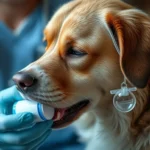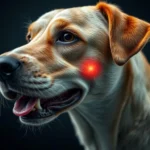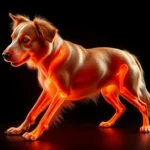
Introduction
Parvo in dogs is a serious and highly contagious viral infection that can lead to severe health complications if not addressed promptly. Canine parvovirus (CPV) is particularly notorious for affecting unvaccinated puppies, but it can also impact adult dogs with compromised immune systems. Understanding the implications of parvo is crucial for all dog owners, as early detection and treatment can save lives.
In this article, we aim to educate pet owners about the nature of parvo, its symptoms, treatments, and preventive measures. It’s essential to seek veterinary advice when dealing with parvo in dogs, as timely intervention is key to recovery.
Understanding Parvo in Dogs
What is Canine Parvovirus?
Canine parvovirus is a viral pathogen that primarily affects dogs, particularly targeting rapidly dividing cells such as those in the intestines and bone marrow. This virus is classified into two main types: CPV-2a and CPV-2b, which can lead to similar symptoms but may vary in severity and transmissibility. The virus is highly contagious, spreading through direct contact with infected dogs or contaminated environments, making it a significant concern for dog owners and breeders alike.
Transmission and Risk Factors
Parvo in dogs is transmitted through:
- Direct contact: The virus can be passed from dog to dog through saliva, feces, or vomit.
- Contaminated environments: The virus can survive on surfaces, clothing, and objects for months, making it easy for unknowing pet owners to bring it home.
Several factors can increase a dog’s risk of contracting parvo:
- Age: Puppies, particularly those between six weeks and six months, are at the highest risk due to their still-developing immune systems.
- Vaccination status: Unvaccinated dogs or those who have not completed their vaccination series are more susceptible.
- Health status: Dogs with underlying health conditions or weakened immune systems are also at greater risk.
Recognizing Symptoms of Parvo
Early Symptoms
Identifying the early symptoms of parvo in dogs is crucial for prompt treatment. Common early signs include:
- Loss of appetite: A sudden change in eating habits can be one of the first indicators.
- Lethargy: Infected dogs may appear unusually tired or less active.
- Fever: Some dogs may develop a fever, although not all do.
Recognizing these early symptoms can be essential in seeking veterinary care before the virus leads to more severe complications.
Severe Symptoms
As the disease progresses, symptoms can escalate rapidly. Severe symptoms of parvo in dogs include:
- Vomiting: Frequent vomiting, often with a severe and foul odor.
- Diarrhea: Watery, bloody diarrhea is common, which can lead to rapid dehydration.
- Dehydration: As vomiting and diarrhea persist, dogs can quickly become dehydrated, leading to additional health risks.
The progression of symptoms can occur within a matter of days, making it imperative for pet owners to be vigilant and proactive in seeking veterinary assistance.
Diagnosis of Parvo
Veterinary Examination
When visiting the veterinarian for suspected parvo in dogs, pet owners can expect a thorough examination. The vet will take a detailed history of the dog’s symptoms and conduct a physical examination. This includes checking for signs of dehydration and abdominal pain, which can provide critical clues about the underlying issue.
Diagnostic Tests
To confirm a diagnosis of parvovirus, veterinarians often use several diagnostic tests, including:
- ELISA test: This test detects the presence of parvovirus antigens in the dog’s feces, providing a quick and reliable diagnosis.
- Fecal tests: These tests analyze stool samples for the virus, helping to confirm or rule out parvo.
These tests are effective and can often provide results within a short timeframe, allowing for timely treatment to begin.
Treatment Options for Parvo
Immediate Care
Once a dog is diagnosed with parvo in dogs, immediate care is vital. Hospitalization is often required to provide supportive care, including:
- IV fluids: To combat dehydration and restore electrolyte balance, intravenous fluids are essential.
- Supportive care measures: Anti-nausea medications and antibiotics may be administered to control symptoms and prevent secondary infections.
Prompt treatment can significantly improve recovery outcomes for dogs affected by parvo.
Long-term Management
Recovery from parvo in dogs can take time, and follow-up care is crucial. Veterinarians typically outline a recovery plan that includes:
- Recovery time: Most dogs will need several days to weeks to fully recover, depending on the severity of their illness.
- Nutritional support: Once vomiting subsides, a bland diet may be recommended to help the dog regain strength.
- Home care tips: Pet owners should monitor their dog closely for any recurring symptoms and keep them hydrated.
Providing a clean, stress-free environment during recovery can aid in the healing process.
Prevention of Parvo
Vaccination Protocols
The prevention of parvo in dogs primarily revolves around vaccination. Vaccination schedules typically include:
- Puppies: Initial vaccinations usually start at six to eight weeks of age, with booster shots given every three to four weeks until they are about four months old.
- Adult dogs: Booster shots are recommended every one to three years, depending on the vaccine used and the dog’s risk factors.
Staying up to date with vaccinations is critical in preventing the spread of parvovirus.
Hygiene and Environment
Maintaining a clean environment is essential for preventing parvo in dogs. Here are some best practices:
- Disinfecting surfaces: Regularly clean areas where dogs spend time, using appropriate disinfectants that can kill parvovirus.
- Avoiding dog parks: Until a puppy is fully vaccinated, it’s best to avoid areas where many dogs congregate, as this increases exposure risk.
New dog owners, particularly those with puppies, should take extra precautions to protect their pets from potential exposure to parvovirus.
Frequently Asked Questions (FAQs)
Common Concerns
Can parvo be treated at home?
– While some mild cases may not require hospitalization, most dogs with parvo need professional veterinary care due to the risks of severe dehydration and complications.
What are the chances of recovery?
– With prompt veterinary treatment, many dogs can recover from parvo in dogs. However, the prognosis depends on factors such as age, overall health, and how quickly treatment begins.
Can vaccinated dogs get parvo?
– Vaccination significantly reduces the risk of contracting parvo, but no vaccine is 100% effective. In rare cases, vaccinated dogs may still become infected, especially if they are exposed to a large viral load.
Myths and Misconceptions
Debunking common myths about parvo in dogs is essential for accurate understanding:
- Myth: Parvo is only a puppy disease.
-
Fact: While puppies are at higher risk, adult dogs can also contract the virus if unvaccinated or immunocompromised.
-
Myth: A dog can recover without veterinary treatment.
- Fact: While some dogs may show mild symptoms, parvo can quickly become life-threatening, making veterinary intervention crucial.
Clarifying these misconceptions can help pet owners recognize the importance of vigilance and timely action regarding their dogs’ health.
Conclusion
Understanding parvo in dogs is vital for every dog owner. By being informed about its symptoms, treatment options, and preventive measures, you can play a crucial role in protecting your furry friends. Always consult with your veterinarian regarding any concerns you may have about your dog’s health.
Prevention through vaccination and maintaining a clean environment are essential in safeguarding against this potentially fatal virus. Stay vigilant and proactive, and together we can ensure our canine companions lead healthy and happy lives.









